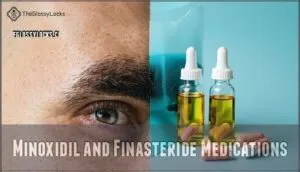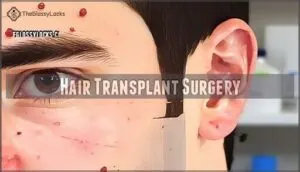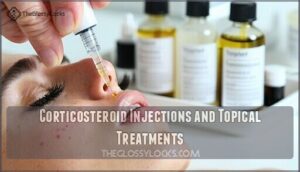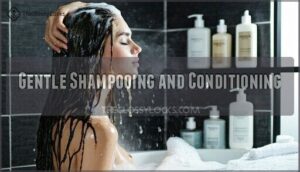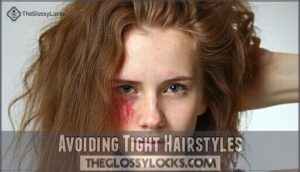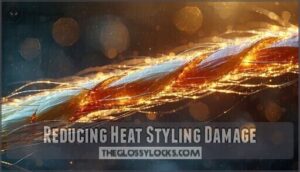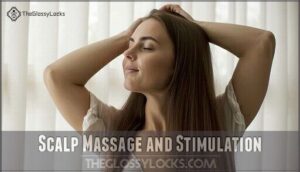This site is supported by our readers. We may earn a commission, at no cost to you, if you purchase through links.
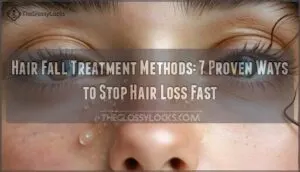
Start with FDA-approved medications like minoxidil or finasteride – they’re your frontline defense.
Medical procedures such as PRP injections and laser therapy show real results too.
Don’t overlook your diet – protein-rich foods and key vitamins fuel healthy growth.
Simple changes like gentle shampooing and scalp massage make a difference.
Natural options like saw palmetto and essential oils offer gentler alternatives.
The key is finding what works for your specific situation.
Some surprising combinations of these approaches deliver the fastest results with proven methods.
Table Of Contents
- Key Takeaways
- Hair Loss Causes
- Medical Treatments
- Dietary Solutions
- Hair Care Techniques
- Alternative Therapies
- Frequently Asked Questions (FAQs)
- What is the best treatment to stop hair fall?
- What is the best permanent treatment for hair loss?
- Is hair loss permanent?
- Do hot showers cause hair loss?
- Does caffeine stop hair loss?
- Can stress cause hair loss?
- Do hair transplants help hair loss?
- Does smoking cause hair loss?
- What is the best cure for hair loss?
- How can I permanently remove hair fall?
- Conclusion
Key Takeaways
- Start with proven medications – You’ll see the best results by combining minoxidil (84% success rate) and finasteride (90% effectiveness) as your foundation treatment.
- Address the root causes early – Don’t wait to tackle genetics, hormonal imbalances, stress, and nutritional deficiencies, since early intervention prevents further damage.
- Support with proper nutrition and gentle care – You’ll strengthen your hair by eating protein-rich foods, taking targeted supplements, and avoiding tight hairstyles or excessive heat styling.
- Combine multiple approaches for best results – You can’t rely on just one method; mix medical treatments with lifestyle changes, scalp massage, and natural remedies for maximum effectiveness.
Hair Loss Causes
You might think hair loss happens by chance, but specific causes trigger most cases of thinning hair.
Understanding what’s behind your hair fall helps you pick the right treatment and stop further damage.
Genetics and Heredity
Most people inherit hair loss patterns from their family tree. Your genes determine when and how you’ll experience thinning hair.
Genetic predispositions activate specific inheritance patterns that control DHT sensitivity. Understanding your genetic blueprint helps you choose targeted hair loss solutions and hair thinning treatment options early.
- Family history reveals your hair loss timeline
- Gene expression triggers male pattern baldness
- Ancestry influence affects hair thickness over time
- DHT blockers can slow genetic hair fall reasons
- Hair loss specialists identify your genetic risk factors
Health Conditions and Diseases
Your body can turn against your hair through autoimmune diseases like alopecia areata, affecting 2% of people globally.
Your immune system can mistakenly attack your own hair follicles, causing unexpected bald patches.
Thyroid disorders disrupt hair cycles in up to 50% of patients. Scalp infections create patchy bald spots while anemia starves follicles of oxygen.
These hair fall reasons require proper diagnosis for effective hair loss solutions targeting underlying scalp health issues. Managing these conditions often requires addressing the immune system’s activity to minimize hair follicle damage.
Medications and Treatments
Between over-the-counter and prescription options, medications can trigger hair fall as unwanted side-effects.
Chemotherapy drugs devastate hair follicles completely. Blood thinners like warfarin cause gradual thinning. Antidepressants disrupt normal growth cycles. Beta-blockers affect circulation to your scalp. Birth control pills alter hormone levels dramatically.
Even acne treatments containing retinoids weaken hair shafts, making strands break easily during routine styling. Many patients find that scalp cooling methods can help to reduce hair loss during chemotherapy.
Physical Stress and Trauma
Your body can’t tell the difference between emotional stress and Physical Shock from accidents or surgery.
Surgical Trauma, car crashes, and severe burns trigger massive hair loss three months later. Childbirth Effects include temporary balding as your system recovers.
Accident Hairloss happens when your follicles shut down during healing. Effective hair fall treatment starts with managing physical recovery properly, and understanding Surgical Trauma is crucial.
Poor Diet and Nutrition
Your diet directly impacts your hair’s health.
Nutrient deficiencies from processed foods and high sugar intake damage hair follicles and disrupt gut health.
Poor nutrition blocks protein synthesis needed for strong hair growth.
A balanced diet with hair vitamins and supplements supports healthy hair diet goals.
Consider hair nutrition as your foundation for effective hair fall treatment.
Medical Treatments
When medications and lifestyle changes aren’t enough, medical treatments offer stronger solutions to fight hair loss.
These advanced options work by targeting the root causes of thinning hair and can deliver faster, more dramatic results.
Minoxidil and Finasteride Medications
Minoxidil efficacy reaches 84% in stopping hair loss within one year.
This topical vs. oral treatment duration requires daily application for hair regrowth.
Finasteride side-effects include sexual dysfunction in under 4% of users.
Combination therapy enhances results for hair thinning solutions.
Elevated DHT levels are a key factor in androgenetic alopecia.
These hair treatment options need consistent use for sustained hair regrowth treatment and hair loss prevention.
Platelet Rich Plasma Injections
PRP therapy involves extracting your blood, concentrating platelets, then injecting them into your scalp.
Your blood becomes the medicine that heals your scalp from within.
This hair regrowth treatment shows promising results through concentrated growth factors that stimulate follicles.
- 60% success rate for visible hair restoration after three sessions
- 20-45% increase in hair density within six months of treatment
- Minimal side effects – just temporary scalp tenderness and swelling
- $500-2500 per session but insurance rarely covers treatment cost
- Monthly sessions required initially, then maintenance every 3-6 months
The injection procedure activates dormant follicles by releasing growth factors.
PRP effectiveness varies by individual genetics and hair loss severity.
Side effects remain mild, though future research continues exploring ideal protocols for hair growth and hair thinning solutions.
Low Level Laser Therapy
LLLT mechanism works by boosting cellular energy in hair follicles through ATP production. Clinical efficacy shows 80% effectiveness rates in real-world studies.
Device types include FDA-cleared helmets and combs for home use. Treatment protocols require consistent sessions over 16-40 weeks.
Optimal wavelengths around 655 nm are often used to maximize hair follicle penetration. Side effects remain minimal with occasional scalp dryness.
These hair fall treatment methods offer safe hair regrowth treatment options, providing a solution with minimal side effects and high effectiveness through clinical efficacy.
Hair Transplant Surgery
Hair transplant surgery offers permanent hair restoration through advanced surgical techniques.
Modern methods achieve 90-95% graft survival rates with proper care.
Consider these key factors:
- FUE technique minimizes scarring and speeds recovery process
- Transplant cost ranges from $4,000-$15,000 depending on coverage needed
- Potential risks include temporary swelling and minor infections
Hair restoration techniques have evolved substantially.
Hair regrowth methods now provide natural-looking results within 9-12 months post-surgery.
Corticosteroid Injections and Topical Treatments
For hair loss from immune attacks, corticosteroid injections and topical treatments target inflammation at the root.
You’ll see regrowth in 60-83% of mild cases within 1-3 months.
| Treatment Type | Efficacy Rate | Treatment Duration | Common Side Effects | Best For |
|---|---|---|---|---|
| Injections | 60-83% regrowth | Every 4-6 weeks | Pain, temporary hollowing | Patchy alopecia areata |
| Topical Steroids | 20-61% complete regrowth | 6 weeks on/off cycles | Skin thinning, irritation | Children, mild cases |
| High-Potency Topical | Up to 96.5% area reduction | Daily application | Atrophy risk with overuse | Localized patches |
Injection side effects stay mild but topical application offers gentler hair fall control for sensitive patients.
Dietary Solutions
Your diet plays a vital role in hair health and can substantially impact hair loss prevention. The nutrients you consume directly affect hair follicle strength and growth cycles.
Mediterranean Diet Benefits
Following the Mediterranean diet can kickstart your hair restoration journey through powerful inflammation reduction and enhanced gut health.
This eating pattern improves nutrient absorption while delivering antioxidant power directly to hair follicles.
The diet’s anti-inflammatory foods support healthy hair growth treatments naturally, and better gut health means your body absorbs hair-boosting vitamins more effectively.
These hair fall control benefits make Mediterranean eating one of the most effective hair loss remedies available, providing a natural approach to hair restoration through enhanced gut health.
Protein Rich Foods for Hair
Building blocks of strong hair start with quality Protein Sources like lean meats, fish, and eggs.
Your Hair Structure depends on amino acids from these foods. Dietary Impact shows protein deficiency weakens hair shafts.
Focus on complete proteins for better Protein Absorption. Omega-3 fatty acids can also improve hair elasticity.
These hair strengthening nutrients support effective hair treatment methods and combat hair fall naturally, utilizing the benefits of complete proteins.
Vitamin and Mineral Supplements
Blood tests reveal which hair supplements actually work. Many people take hair vitamins health products without knowing their nutrient levels first.
Consider these supplement absorption factors:
- Iron deficiency causes hair loss in women – test ferritin levels before supplementing
- Vitamin D deficiency links to androgenetic alopecia and telogen effluvium
- Biotin supplements only help those with true deficiency, not healthy individuals
- Zinc excess from hair growth supplements can worsen hair loss
- Supplement interactions affect bioavailability factors – vitamin C enhances iron absorption
Follow dosage guidelines carefully. Vitamin D products may help with deficiencies. Watch for deficiency symptoms like thinning hair before starting hair loss supplements.
Hydration and Water Intake
Your scalp needs steady moisture like a garden needs regular watering.
Drink eight glasses daily to maintain ideal hydration levels and scalp moisture.
Cold water temperature helps seal hair cuticles while warm water opens them for cleansing.
Proper water intake supports hair hydration from within, delivering nutrients through your bloodstream to follicles for stronger hair health and ideal hydration levels, which is essential for maintaining scalp moisture.
Foods to Avoid for Hair Loss
While proper hydration supports healthy hair, certain foods can sabotage your efforts.
Sugar consumption and processed foods spike insulin levels, shrinking hair follicles. High-glycemic index foods like white bread trigger inflammation that weakens hair roots.
Artificial sweeteners and excessive alcohol intake block nutrient absorption your follicles need. Skip the junk food for better hair loss management and stronger strands, and remember that proper hydration and avoiding high-glycemic index foods are key.
Hair Care Techniques
Your daily hair care routine plays a vital role in preventing further hair loss.
Simple changes to how you wash, style, and treat your hair can make a significant difference in maintaining healthy follicles and reducing breakage, which is crucial for your daily hair care routine.
Gentle Shampooing and Conditioning
Your shampoo ingredients matter more than you think. Harsh sulfates strip natural oils that protect your scalp. Choose gentle, sulfate-free formulas instead.
Here’s your washing game plan:
- Wash every 2-3 days – Daily washing removes protective oils
- Apply conditioner mid-length to ends – Skip your scalp to avoid buildup
- Use lukewarm water – Hot water damages hair follicles
Antihair fall shampoo works best when paired with matching hair care products. Focus on scalp health through proper product application and washing frequency.
Avoiding Tight Hairstyles
Tight ponytails and braids cause traction alopecia by pulling hair from roots.
Choose loose hairstyles to prevent hair fall. Rotate styling patterns weekly. Use soft hair ties instead of rubber bands for gentle styling.
| Tight Style Risk | Protective Alternative | Breakage Prevention |
|---|---|---|
| High ponytails | Low loose buns | Silk scrunchies |
| Tight braids | Loose waves | Satin pillowcases |
| Hair extensions | Natural texture | Weekly style rotation |
| Slicked-back looks | Side parts | Leave-in conditioner |
| Elastic bands | Fabric ties | Scalp massage |
Reducing Heat Styling Damage
Turn down the heat on your styling tools to prevent hair breakage solutions.
Heat protectants create a barrier between your hair and damage.
Lower heat settings work just as well as maximum temperatures.
Air drying benefits include reduced stress on hair follicles.
Quality styling tools distribute heat evenly.
Proper hydration importance maintains hair strength and elasticity.
Temperatures exceeding 300°F can cause protein structure breakdown.
The key to preventing damage is using heat protectants, maintaining proper hydration, and being mindful of hair breakage.
Scalp Massage and Stimulation
Daily scalp massage boosts blood circulation and promotes follicle health through gentle stimulation techniques.
Use your fingertips in circular motions for five minutes, or try stimulation tools like scalp brushes.
This simple practice reduces stress while encouraging hair growth.
Regular massage treatments support scalp health and can complement other hair growth solutions for stronger strands, making it a great addition to your routine for overall scalp health.
Homemade Hair Masks and Treatments
Weekly DIY mask recipes can transform your scalp health using kitchen ingredients.
Mix egg yolk with olive oil for protein-rich nourishment. Combine honey and coconut oil for moisture.
Apply these natural hair remedies using gentle massage techniques. Store leftover masks in the refrigerator for three days.
See DIY hair mask products for specialized ingredients. These hair growth tips cost pennies compared to salon treatments, offering a natural alternative.
Alternative Therapies
When medical treatments don’t work or you want natural options, alternative therapies can help slow hair loss.
These methods include herbal supplements, essential oils, and simple lifestyle changes that support healthy hair growth, which can be considered as natural options.
Saw Palmetto and Ginseng Supplements
Beyond gentle hair care practices, you can explore natural supplements for hair growth support.
Saw Palmetto blocks DHT production, showing 27% increased hair count in studies, and should be taken 200-320mg daily for best results.
Ginseng benefits include improved follicle health and reduced inflammation, with both hair fall supplements carrying minimal side effects but requiring consistent use for months to see improvement, which supports overall hair growth.
Essential Oils for Hair Growth
Several essential oils show promise for supporting hair growth through clinical research.
These natural compounds work by improving scalp health and blood flow to follicles.
Key hair growth oils include:
- Rosemary oil – Matches minoxidil effectiveness in studies with less scalp irritation
- Peppermint oil – Accelerates follicle growth and increases hair thickness
- Lavender oil blends – Improved hair loss in 44% of participants versus 15% placebo
- Cedarwood oil – Strengthens hair when combined with other oils
- Clary sage oil – Protects against stress-related hair loss
For oil application, dilute 2-3% essential oils in carrier oils like jojoba.
Massage into scalp nightly for three to six months.
Oil blends often work better than single oils for thorough scalp health support.
Coconut and Olive Oil Benefits
Natural oils work like liquid gold for your scalp.
You’ll find coconut oil penetrates hair shafts while olive oil coats strands for protection.
These oils boost scalp health and hair strength naturally.
| Oil Type | Key Benefits |
|---|---|
| Coconut Oil | Deep penetration, reduces protein loss |
| Olive Oil | Surface protection, shine enhancement |
| Mixed Blend | Combined scalp health benefits |
| DIY Recipes | Custom hair treatment options |
| Application | Improved hair growth tips results |
Both oils reduce hair fall through different mechanisms.
Coconut oil’s composition includes lauric acid that strengthens follicles.
Olive oil creates a protective barrier.
You can create simple DIY recipes by warming either oil and massaging into your scalp.
These best hair oil options work as effective hair fall products when used consistently.
Lifestyle Changes for Hair Loss Prevention
Simple changes can make a big difference in your hair health journey.
Regular exercise benefits your scalp by boosting blood circulation and delivering nutrients to hair follicles. Focus on stress reduction through meditation or yoga since chronic stress disrupts hair growth cycles.
Good sleep hygiene helps your body repair and regenerate hair cells overnight. Stay hydrated – proper hydration habits support healthy hair from within.
Protect your scalp from sun damage with hats or UV-blocking products for ideal hair health tips.
Quitting Smoking and Reducing Stress
You can break the cycle of hair loss by addressing two major culprits.
Smoking cessation improves blood flow to your scalp, delivering essential nutrients to hair follicles.
Stress management through mindfulness practices and exercise benefits your entire body.
Build support networks for accountability.
These hair loss resources offer real solutions when you’re ready to take control.
Frequently Asked Questions (FAQs)
What is the best treatment to stop hair fall?
Minoxidil and finasteride are your most proven options. Minoxidil helps 84% of men stop hair loss, while finasteride works for nearly 90%. You’ll need consistent use for months to see results.
What is the best permanent treatment for hair loss?
Hair transplant surgery offers the most permanent solution. You’ll move healthy follicles from donor areas to balding spots. Results last decades since transplanted hair retains its growth characteristics permanently.
Is hair loss permanent?
Most hair loss isn’t permanent. You’ve got options like minoxidil and finasteride that can slow or reverse it. Early treatment works best, so don’t wait if you’re noticing changes.
Do hot showers cause hair loss?
While hot showers don’t directly cause hair loss, they can weaken hair strands by stripping natural oils and drying your scalp.
You’re better off using warm water and limiting shower time to protect your hair’s health.
Does caffeine stop hair loss?
While caffeine shampoos won’t magically restore your hairline like espresso fixes Monday mornings, research suggests topical caffeine can stimulate hair follicles and improve circulation.
You’ll need consistent use for months to see potential benefits.
Can stress cause hair loss?
Yes, stress can definitely cause hair loss.
When you’re stressed, your body releases hormones that disrupt hair growth cycles, leading to increased shedding or temporary hair loss conditions like telogen effluvium.
Do hair transplants help hair loss?
Research shows 95% of hair transplant patients see permanent results.
You’ll get real hair that grows naturally since surgeons move your own follicles from dense areas to thinning spots.
The transplanted hair won’t fall out.
Does smoking cause hair loss?
Smoking restricts blood flow to your hair follicles, depriving them of essential nutrients and oxygen needed for healthy growth.
This reduced circulation can weaken hair strands and accelerate loss over time.
What is the best cure for hair loss?
No single cure exists for hair loss. The most effective treatment combines 1mg oral finasteride with 5% topical minoxidil. This approach works for up to 90% of men with male pattern baldness.
How can I permanently remove hair fall?
While truly "permanent" removal isn’t always achievable, you can substantially control thinning by combining proven treatments like minoxidil and finasteride with lifestyle changes.
These methods effectively halt progression in most people when started early.
Conclusion
Remember, hair loss isn’t a life sentence – it’s a puzzle waiting to be solved.
The most effective hair fall treatment methods combine multiple approaches customized to your specific needs. Start with proven medical treatments like minoxidil or finasteride.
Add proper nutrition and gentle hair care practices. Consider natural alternatives if medications aren’t suitable.
Track your progress over several months. Consistency matters more than perfection. With patience and the right combination of treatments, you can achieve meaningful results.
- https://www.ncoa.org/article/hair-loss-medication-guide/
- https://nyulangone.org/conditions/hair-loss/treatments/medication-for-hair-loss
- https://dermatologyofct.com/exploring-new-and-traditional-medications-for-hair-loss-what-you-should-know/
- https://www.drmalaymehta.com/blog/latest-hair-transplant-technology/
- https://www.health.harvard.edu/staying-healthy/treating-female-pattern-hair-loss

